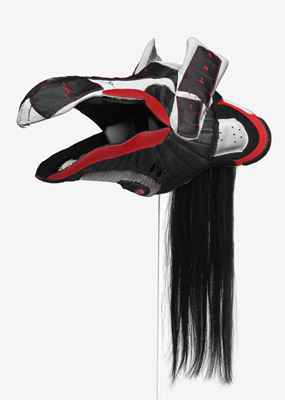Brian Jungen

Prototype for New Understanding #16, 2004
Nike athletic footwear, human hair
Collection of Joel Wachs, New York
Photo: Trevor Mills, Vancouver Art Gallery
(taken from Brian Jungen Gallery)
I’m very late getting this written – it was 11 days ago that we went to the Vancouver Art Gallery to see the exhibitions and I promised to write about them later. I’ve written about the Takao Tanabe retrospective, now it’s time for Brian Jungen’s, whose show is still up until the end of this month. It’s an absolute must-see if you are in the Vancouver area!
As it will be gone soon, I’ve captured this statement from the Vancouver Art Gallery site:
THE FIRST COMPREHENSIVE SURVEY of work by Brian Jungen opens at the Vancouver Art Gallery January 28 and will remain on display until April 30, 2006.
Organized by the Vancouver Art Gallery and comprised of more than 40 works ranging from early drawings and sculptures to large-scale installations, Brian Jungen brings together the artist’s major series and key singular works for the first time. Following critical acclaim at the New Museum of Contemporary Art in New York, the exhibition is significantly expanded for its return home with the addition of artworks including several pieces currently in production, being created specially for the Vancouver presentation.
Born in Fort St. John, BC, Jungen moved to Vancouver as a young adult, graduating from the Emily Carr Institute of Art + Design in 1992. In 2002, he was awarded the inaugural $50,000 Sobey Art Award, the most lucrative Canadian award for emerging artists, in recognition of outstanding achievement. Today, Jungen is a key figure in Vancouver’s art community and has gained an international reputation as one of Canada’s most promising contemporary artists with an upcoming exhibition at the Tate Modern.
Through the transformation of consumer goods and common materials into symbolic sculptures and installations, Jungen examines cultural norms and social issues. The artist is perhaps best known for his Prototype for New Understanding series (1998-2005), 23 startling simulations of Northwest Coast Aboriginal masks fabricated from disassembled athletic shoes. Through this ingenious manipulation, the artist collides two seemingly different commodities-globally branded footwear and revered First Nation’s artwork.
Also widely celebrated are Jungen’s three enormous and incredibly lifelike whale skeleton sculptures-Shapeshifter (2000), Cetology (2002) and Vienna (2003). Made from common plastic lawn chairs, his “whales” oscillate between objects of natural history and critiques of commodity culture, simultaneously understood as both natural forms and recognizable household objects. Cetology, the largest of the three measuring 49 feet in length, is in the Gallery’s permanent collection.
One of the first public institutions to collect works by Jungen, the Vancouver Art Gallery has drawn from its own collection for the exhibition, as well as from the collections of the Art Gallery of Ontario, the National Gallery of Art (Ottawa) and other Canadian museums, as well as numerous private collections.
I first became aware of Brian Jungen when I saw his work almost two years ago in the group show Baja to Vancouver, also at the VAG. I clearly remembered those pieces, a couple of his masks made from black and white Nikes. I am always impressed when First Nations artists can take their traditional motifs and rework these in a contemporary fashion, in both medium and message, and Jungen did this very dramatically.
Last week, walking into the room displaying the whole Prototype for New Understanding series of masks, I was immediately struck by the fact that they were displayed in glass cases, just as if they were in an anthropology museum! And it was fascinating to watch the excited reactions of the other visitors, many of them families with preteens. I think most people recognized ‘the multiple references to animal and supernatural figures of North West Coast ceremonial masks and pop cultural icons”. Originally used in dances and ceremonies, they later became “collectibles and artifacts”. Jungen has made a deliberate gesture against the “rigid terms of ownership, purity and authenticity”, making it about “transformation of the mythical into the mundane”. (..from my loosely and not too accurately scribbled notes taken off the gallery wall).
View several images of Jungen’s works at Brian Jungen Gallery.
Brian Jungen and his success inspired several articles in our local papers, such as in The Tyee, by Danielle Egan, in the Straight by Alexander Varty, and in the Vancouver Sun by Amy O’Brian. And, the New Museum of Contemporary Art in New York City still has their page on Jungen’s recent exhibition there.
April 22, 2006 in Art Exhibitions, Other artists by Marja-Leena
Valloittavia nuo Jungenin työt, suorastaan huikeita! Pahus kun tuo näyttely on niin kaukana, sinne ei ihan äkkiseltään täältä Pohjois-Euroopan perukoilta piipahdeta 🙂
Tämä oli todella kiinnostava kirjoitus. Tämä on ollut aina ominaista Amerikan alkuperäiskansojen taiteelle: otetaan vaikutteita muista kulttuureista ja muokataan ne miltei tunnistamattomiin.
Viides rooli, hauska että tykkäät. Nuo kuvat tietysti ei anna täyden elämyksen kuin paikalla olisi, jotta hyvin ymmärrän halun ja varat saada hypätä lentokoneeseen ja piipahtaa mihin kinnostavaan taidenäyttelyyn missa vaan. Euroopassahan on paljon kiinnostavaa.
Anna, hyvä pointti, en tullut ajatelleeksi avain siltä kannalta, ainakin täällä BCssä. Nykyään on hirveen paljon kutsuntaa heidän työlle, paljon siitä on hyvin tehty mutta vanhan taiteen kopiointia ja usein vain koristeellista. Jungenin työ on mahtava koska siinä on uusi näkemys, uniikki asenne – sehän on taidetta.
That is totally far out. I love the way this guy’s mind works.
The only way this could be better would be if Jungen’s masks and whale skeletons were displayed not in art museums, but in natural history museums! Really, they conjure up a whole new meta-museum, if I may say so without sounding impossibly pretentious.
Wow, Dave, you really ARE excited by Jungen’s work, and you haven’t even seen it in real life!! Natural history museums sound really good! I could visualize it in our fabulous UBC Museum of Anthropology too. I’m amazed how quickly he became successful – his work really excites everyone.